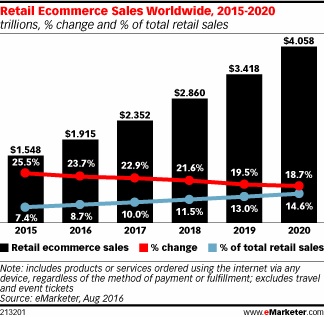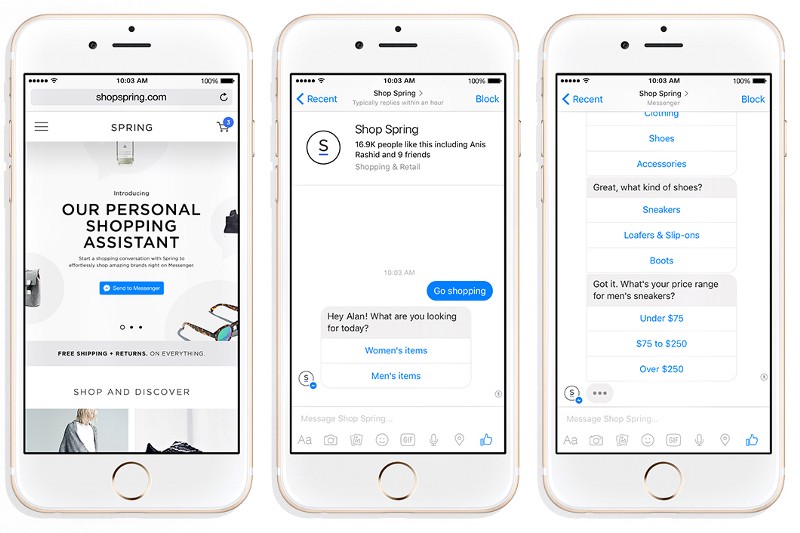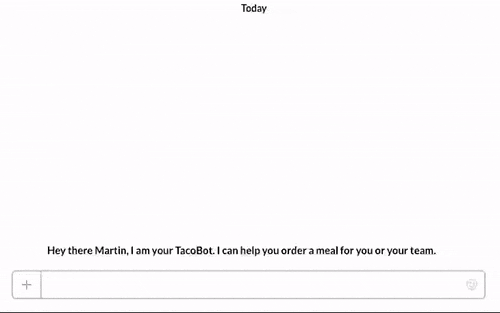Did you know, the global retail e-commerce sales is forecasted to be around $1.95 trillion in 2016, accounting for 8.7% ($22 trillion) of total retail spending worldwide (eMarketer). While the pace of growth in overall retail sales is subdued at 6.0%, the e-commerce sales continue to grow rapidly at 23.7%. It does not end there, the double-digit growth is expected to continue through 2020.
Image Source – eMarketer
While Asia-Pacific remains the world’s largest and fastest growing retail e-commerce market, North America continues to remain an important e-commerce market (forecasted to reach $423.34 billion, 15.6% YoY growth).
These stats are an indication of the growing prominence of e-commerce in the world of retail. No, we are not forecasting the death of brick and mortar stores but, they will have to evolve to remain relevant. Retailers will have to fully embrace digital commerce to meet the growing demands of their customers, to survive.
A word of caution. By embracing digital commerce, we do not mean the mere presence of an e-commerce store. Retailers will have to include e-commerce in their overall business strategy and give e-commerce its due attention. Why? Because technology will continue to disrupt e-commerce and retailers will have to continue embracing the change to stay current.
In this article, we will highlight the key e-commerce trends that you as a retailer must keep your eyes on as you continue evolving your digital presence.
Rising Popularity of Other Channels and their Synergy with E-commerce
1) Getting it Right with Mobile Commerce
According to Gartner, By 2017 U.S. customers’ mobile engagement behavior will drive mobile commerce revenue to 50 percent of U.S. digital commerce revenue.
Mobile commerce will continue to evolve and gain strength in 2017; even take the center stage. Sooner than later, retailers will have to incorporate mobile devices in their commerce strategy and leverage mobile devices as a means to provide a more sophisticated and convenient customer experience.
On Black Friday 2016, a whopping $1.2 billion were spent via mobile devices, a 33% growth YOY (Adobe Digital’s Report). Cyber Monday was not far with $1.07 billion spent via mobile devices (34% increase YOY).
Beyond mobile commerce sales, mobile devices will continue playing an important role in the overall customer experience with more and more customers reaching out for their mobile devices for everything from searching information, comparing prices, reading reviews, customer support and more.
2) Rising Popularity of Social Commerce
According to marketingweek.com, 31% of online shoppers say they use social media channels like Facebook, Instagram, and Pinterest to specifically look for new items to purchase.
With pressure mounting on social media platforms to diversify their revenue stream to keep shareholders happy, several platforms have rolled out features to allow product purchases from directly within their apps.
In October 2016, Facebook announced additional developments to the site’s dedicated shopping section – visitors could now directly buy items on the platform instead of being redirected to the retailer’s site. Likewise, Facebook-owned Instagram also opened up its site to all advertisers with newer direct response ad formats which encourage users to take actions on posts through buttons such as ‘shop now’, ‘install’ or ‘learn more’; this was last year. Snapchat has also declared its plans to roll out a new e-commerce platform, while Twitter has already tested a ‘buy’ button on its feed.
A number of brands are already present on most of these platforms and actively engage with their customers. They should leverage these shopping habits when thinking about their social media strategy for 2017.
3) Digitalize the Physical Store Shopping Experience
The regular retail physical store will continue to evolve into smarter environments. Come 2017 brands will blend in technology to build a connected store designed to provide customers a uniform and seamless shopping experience. The new setup will make way for options like buy online pickup in store, buy in store return online, etc.
Amazon Go, Amazon’s new experimental grocery store recently launched in Seattle, is an amazing example of how technology can revolutionize the brick-and-mortar stores. The store allows shoppers to buy goods (with sensors tracking items as the shopper picks and places an item into the basket) without needing to stop at a checkout line for payment. This also is a testimony to the fact that brick-and-mortar are here to stay (while most retailers are focusing on getting their business online, Amazon is setting up brick-and-mortar stores), just not in the old format.
4) Disintermediation
A number of brands in 2016 have started reaching out directly to customers to have better control over their brand experience. A move welcomed by customers because they now get to directly interact with the brand and share their feedback & concerns.
E-commerce has made it convenient for both B2B and B2C manufacturers and retailers to make a sale with the end user. In 2017, brands will have to find the right balance between their traditional distribution channels and the new direct-to-consumer e-commerce store. While distributors and merchants will have to work hard to strengthen their relationship with customers by providing value through other mechanisms.
We have also worked with manufacturers that have smartly adopted e-commerce to augment their existing sales channels while others have adopted e-commerce to reach target market not targeted by their existing distribution channels. However, the intentions are clear – leverage e-commerce to reduce dependency on their existing distribution channels and have better control over the brand experience.
5) IOT Enabled E-commerce
The phenomenon of Internet of Things has long been influencing e-commerce by connecting everyday smart devices ranging from home appliances to cars – the underlying point being the fact that each of these connected devices can double up as a supplementary point of sale or exclusive selling channels.
Consider this, according to Cisco, there will be more than 40 billion connected devices by 2020.
Amazon Dash Button, a wifi enabled device that lets customer re-order favorite products by simply pushing a button from the convenience of the home is an amazing example of this. Volvo Sensus Park & Pay, HP Instant Ink, and Telefonica Click and Pizza are some brands that are using IoT-enabled eCommerce to their advantage.
Marketing & Promotion Trends Affecting E-commerce
6) SEO, Google Updates and Emphasis on the Mobile User Experience
E-commerce has had love and hate relationship with Google in 2016. While a number of brands rely heavily on Google to be discovered and to drive traffic to their e-commerce store, Google had upset many businesses with their frequent algorithm changes (penalties for certain SEO techniques, for bad experience on mobile devices, for pop-ups, etc.).
While brands are looking for ways to reduce dependency on Google, brands cannot ignore them. Brands in 2017 will have to make necessary changes to comply with Google’s algorithm changes.
7) Welcome Cyber November, No more Black Fridays or Cyber Mondays
The whole of November in the year 2016 marked a holiday shopping season with shopping activities taking on a new spread out buying rhythm. Come 2017, online retailers will have to spread promotions to the entire month while being flexible to accommodate adjustments along with way. Over the years, we have seen brands release their promotional offers on a specific day (Black Friday, Cyber Monday) to releasing promotional offers weeks in advance.
According to US Department of Commerce, total retail sales in U.S. reached $465.51 billion in November 2016, with non-store sales contributing $48.13 billion. According to Google, 40% of Canadian consumers start their holiday shopping before Halloween and 88% of retailers in the U.S start advertising sales in the first week of November.
Black Friday /Cyber Monday will no longer signal the start of the holiday shopping season; the entire shopping season is slated to kick off early November, hence the name “Cyber or Black November.
8) Videos and User Generated Content will Dominate
The Millennial consumers have taken to the digital medium over traditional channels. They feed on visual content and are very passionate & vocal about their brands.
Consider this
- A recent comScore/ YouTube study found that about 35 % of Millennial prefer to watch YouTube compared to 18% that preferred traditional television programming. 74% of which said they liked to watch videos that brands, companies, or institutions had uploaded.
- According to comScore, brand engagement increases an average of 28% when users are exposed to a combination of user created product videos and professional content.
- User generated videos on YouTube get 10x more views than content created and uploaded by the actual brand (source).
- According to Adweek, 93% of consumers find UGC to be helpful when making a purchasing decision.
- According to BazzarVoice, 86% of Millennials believe that UGC is a good indicator of a brand or product’s quality.
In 2017, e-commerce content marketers will have to focus on videos and user generated content to better attract and influence their customers.
Payments, Shipping & Returns Trends to Drive E-commerce Conversions
9) Mobile Wallets to Reduce Transactional Friction
According to Business Insider, in the U.S. in-store mobile payment volume will reach $75 billion this year (2016). Between 2015-2020, the volume is expected to rise by a compound annual growth rate (CAGR) of 80% to bring mobile payments volume to $503 billion by 2020.”
In this light; PayPal recently rolled out the PayPal Here Chip Card reader which is compatible with both iOS and Android devices; it accepts both EMV and magnetic stripe cards, as well as NFC payments which technologies such as Apple Pay, Android Pay, and Samsung Pay use.
By aggressively adopting mobile wallet payment platforms, merchants will be able to deliver benefits to their customers as well as themselves by bringing down transactional friction. Customers can be exposed to a wider array of payment options, brought about by mobile, tech wearable and just about any other payment-enabled technology.
10) On Demand Delivery and Same-day Delivery are the New Standards
According to Forrester, 29% of consumers would be interested in, and would be willing to pay more, for same-day delivery of goods in 2016 and beyond.
Amazon has set new benchmarks as far as delivery standards are concerned. Though Amazon Prime comes with a fee, along with a whole bouquet of services, the marketplace’s one-day and two-day delivery options are in many cases free of charge. With Amazon testing delivery times with drone delivery, same delivery is the new norm. Brands have also started experimenting with buy online pickup in store, local drop-off points, etc. to deliver products on the same day.
Further ahead customers will demand greater control over the time and date of their delivery; logistics startups such as Postmates offer on-demand delivery and same day delivery across a number of cities nationwide.
11) Amazon like Returns Process set New Benchmark
According to business2community.com, 67% of shoppers check returns page before making a purchase and 62% of shoppers are more likely to shop online if they can return an item in-store.
An automated return processing system that delivers an Amazon like shopping experience is what customers demand. Solutions such as Ready Returns, make this possible by integrating into the e-store to facilitate easy and automated returns. Customers can process a return and generate a prepaid shipping label in no time at all.
With such solutions in place, shoppers will only have to return goods to the same site they made a purchase from. The retailer is also notified of inventory updates to warehouses and detailed analytics reports can be generated. All that a retailer now needs to do is set up business specific customized rules for returns to control return shipping costs before using the application.
Analytics/ Data to take Center Stage
12) Real-time, Signal-driven Analytics to Fuel Decision Making
Real-time, signal-driven analytics provide retailers with a deeper insight into the data by giving them the ability to explore data in greater depth which was never possible before. Retailers can zero down on conversion points with a high level of accuracy and act on results with a lot more conviction.
Kissmetrics pioneers such efforts. They sell software that helps to track signals to every sales channel and a possible conversion source; follow it from either its source, conversion, an abandonment or a bounce source. Real-time signal based information actively aid in assessing audiences better and in staying ahead of the game to drive healthier conversions across the board.
13) Predictive Analysis and Personalization
Predictive analysis is a technology that exploits massive amount of data collected from various interaction points. This is fast gaining popularity, with merchants leveraging this information to understand consumers’ purchasing habits and preferences to predict subsequent purchases and to personalize their shopping experience.
Armed with this, retailers will be able to take personalization to new levels. Magento’s recent acquisition of RJMetrics, an advanced cloud-based analytics solution, is a testimony to that. According to a recent Forrester Research report, most firms only use one-third of the data that they collect. Worse, only 29% say they are good at translating the result of data and analytics into measurable business outcomes. RJMetrics will make it convenient for Magento e-commerce store owners to better understand and optimize their commerce business based on actionable data and insights into customers, merchandising, channels, and more.
Customer Experience becomes the Key Differentiator
14) VR /AR to Bridge Gaps in Customer Experiences
While VR/ AR has been around for quite some time, they are now slowly becoming mainstream. VR and AR technologies help e-commerce merchants provide customers the brick-and-motor kind of an experience. By providing customers with an all-round near real-life view of products, merchants can take customer experience to a new level.
Samsung’s Gear VR headset has hit the shelves in mid-2016 sale followed by Oculus Rift and Sony PlayStation VR; there is no doubt VR and AR are being embraced by many marketing and content teams as a strategy to deliver revolutionary retail experiences. The only glitch here is the cost; the headsets remain expensive and are not mass produced (apart from Google Cardboard). The phase is changing, and sooner than later, VR will become an integral part of retail.
15) Chatbots and Virtual Assistants to Drive Conversational Commerce
Chatbots and Virtual Assistants are artificial intelligence driven tools that interact and assist customers with a range of activities, e-commerce being one of them. These tools can answer queries (customer service), create shopping lists, recommend products and places, and even place orders. Now, this leads to a slew of new opportunities for businesses to drive customer engagement.
These AI driven tools can be made available in mobile devices, messaging apps, website, or specific hardware devices like Google Home and Amazon Echo. These, are very likely become the first touch point for customers (who will appreciate the personalized human-like interaction that makes them feel special) to interact with brands (as they can very easily manage and drive simultaneous one-to-one conversations with multiple customers).
Facebook, WhatsApp, Twitter, Google, and Amazon are all introducing chatbots and virtual assistants to help with shopping, booking and customer service. Customers can now order flowers from 1-800-Flowers, browse the latest fashion and make purchases from Spring, and order an Uber, all from within Facebook messenger chat.
Image Source – VentureBeat
Other examples include customers using Alexa (Amazon Echo) to order products from Amazon, Taco Bell creating their own slackbot, Tacobot, to accept orders from customers, Pizza Hut accepting orders through Facebook and Twitter chatbots, etc.
Image Source – VentureBeat
16) The Push for Omni-channel Experience
According to Boston Retail Partners, 18% of the retailers surveyed in 2016 have indicated that they have implemented a unified commerce/integrated commerce platform and two-thirds of them indicated that they need to further work on the approach.
But why is a unified commerce system or an integrated commerce system important? Because, it is no longer just about the product, brand, or channel. A seamless shopping experience plays a very important role in deciding where customers buy and in driving customer loyalty.
To deliver that, businesses will either need to adopt a system that can do everything for them or integrate their existing systems to create a virtual unified commerce system. Bottom line, deliver a seamless unified shopping experience across channels. As they say, drop the ‘e’ and capitalize the ‘c’ — it’s all about Commerce (NRF).
Centralized data (customer, order, and others), also makes way for improved analytics and decision-making. Businesses can create reports like sales across channels, customer behavior across channels, customer shopper journey, top performing products by channel, and more.
Frankfurt Airport, one of Europe’s largest travel hubs that served 61 million passengers in 2015, adopted Magento to power a first-of-its-kind omni-channel commerce experience for Frankfurt Airport (FRA) travelers. By building an infrastructure that unifies all its merchants, and by working on a strategy that spans more than just owned channels like stores, kiosks, online and mobile they set the base for providing the travelers an amazing shopping experience. The travelers can pre-order from any store or combination of stores while still in the air, on-site, or in a taxi on the way to the airport – even the day before traveling.
Security & Hosting cannot be Ignored
17) The Shift towards Cloud
According to Statista, cloud computing is predicted to rake in $15.4 billion in 2017.
Everyone and everything is moving to cloud. A trend that picked pace in 2016, 2017 will see more brands and retailers moving to cloud. Not just with their e-commerce system but even back-office systems like ERP. E-commerce and ERP players like Magento (Magento Cloud) and Microsoft Dynamics (Dynamics 365) are betting big on the cloud. Do you check out Nexcess, one of the best Magento hosting provider.
With Magento Cloud, retailers can stop worrying about monitoring servers, upgrades, security and more. They also promise faster deployment and enhanced performance, making Magento Cloud an offering difficult to ignore.
18) Renewed focus on Security
Another upcoming trend in e-commerce is the steady adoption of biometrics by e-tailers to enhance consumer security on e-commerce sites. The use of fingerprint, voice, iris and facial detection technology, biometrics not only enhances security but can also act as a serious analytics tool.
Systematixinfotech.com explains: “Apple experienced an increase in sales when they added the fingerprint scan to iPhone. Many studies suggest that by 2017, more than 500 million people will be using phones installed with biometric technology. Various technology firms like MasterCard and Visa are already working on making biometric technology an essential part of payment systems.”







